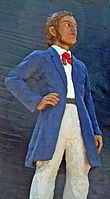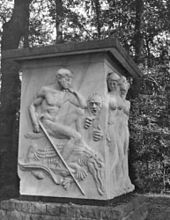Richard Wagner Monument (Leipzig)
The Richard Wagner Memorial in Leipzig was unveiled in 2013 on the occasion of the 200th birthday of Richard Wagner (1813–1883). It was created by Stephan Balkenhol (* 1957) using the base designed 100 years ago by Max Klinger (1857–1920).
location
The Richard Wagner monument is on the north-west side of Leipzig city center in the green areas on Goerdelerring , at the point that was planned for the beginning of the 20th century. It stands on a staircase that led from the butcher's place to the Matthäi churchyard . With the completely changed architectural environment - behind the stairs there is an office building that was formerly built for the Stasi - it has no functional significance in the city.
description
The base of the monument resting on the staircase is the white marble cuboid designed by Max Klinger. It has an edge length of 2 meters and is 2.9 meters high. Three of its sides show larger-than- life-size reliefs from Richard Wagner's work. On the front, the three Rhine daughters from the opera cycle Der Ring des Nibelungen are depicted as naked women . They should symbolize music, poetry and drama at the same time and thus allude to Wagner's pursuit of the total work of art . On the left side you can see Siegfried , Mime and the killed dragon , on the right the keeper of the Grail Parsifal and the Grail messenger Kundry .
On the pedestal stands the young Wagner as a colored bronze statue 1.8 m tall in everyday clothes. Because next to his place of birth Leipzig is the place of his training years. Behind this figure rises four meters high like a shadow a black bronze plate with the outlines of the older Wagner, symbolizing his great life's work. The silhouette of the shadow quotes Klinger's design for a statue by Richard Wagner. Balkenhol himself described his design of the monument as a paraphrase of Klinger.
history
First efforts to erect a Wagner monument in Leipzig go back to 1883. On his 70th birthday, three months after his death, a committee collected donations and considered locations for a memorial. After a few unsuccessful drafts, a monument committee under Lord Mayor Bruno Tröndlin (1835–1908) approached the Leipzig public in 1903 with an appeal for donations and won the then most famous Leipzig artist, Max Klinger, for the execution. A first draft envisaged a four-meter-high figure of the composer made of white marble wrapped in a long black coat made of heavy material, which was to stand at the Old Theater . Work on this had already progressed until the marble block was purchased in Laas (South Tyrol) , when Klinger submitted new plans to the current mayor Rudolf Dittrich (1855–1929) in 1911 . Now a 5.3 meter high Wagner figure was to be placed on a 3 meter high pedestal with reliefs on the stairs between Fleischerplatz and Matthäikirchhof. Otto Wilhelm Scharenberg (1851–1920) extended these stairs according to Klinger's plans, and for the composer's 100th birthday in 1913, when the monument was supposed to be finished, the foundation stone was laid on the stairs at the site of today's monument . After that, nothing changed there for a long time.
Klinger sent the plaster models for the reliefs to Lasas to be transferred to the marble pedestal and had a second large block broken for the marble statue. The outbreak of the First World War , financial difficulties and finally Klinger's death in 1920 prevented progress. The pedestal came to Leipzig in 1924 and, after being revised by the Leipzig sculptor and Klinger's estate supervisor, Johannes Hartmann (1869–1952), was erected in the Klingerhain, the southern part of the Palmengarten . It was here for over 80 years, sometimes referred to as the “porn cube” because of the naked Rhine daughters.
With regard to Wagner's 50th anniversary of his death, a new memorial project was started in 1932 under Lord Mayor Carl Goerdeler (1884–1945). The sculptor Emil Hipp (1893–1965) won an ideas competition . For what is now the "Richard Wagner National Monument", the foundation stone was laid near the Elster Basin on March 6, 1934 by Adolf Hitler (1889–1945) at Goerdeler's side. The figures and friezes made by Hipp for the monumental monument until 1944 could not be brought to Leipzig before the end of the Second World War . After that, the city of Leipzig refused to take them over because of the supposed ideological burden on the monument, even though they had already been paid for. The associated park, the Richard-Wagner-Hain, was preserved in the city .
On the occasion of the 170th birthday and the 100th anniversary of Richard Wagner's death, a Richard Wagner bust based on a design by Max Klinger was erected in 1983 in the park at the Schwanenteich north of the opera .
In 2005 Wagner enthusiasts organized themselves in the Wagner Memorial Association e. V., whose aim was to have the 1911 Klingersche Wagner monument completed. The Klinger Association also participated in the company. Nine artists submitted their designs in a competition. Among the last three remaining in a selection, the jury decided in 2011 in favor of Stephan Balkenhol's design , followed by a heated public discussion. In the meantime, the staircase that was demolished in the 1970s had been rebuilt in 2010 and the Klingersche monument base was attached to it. To finance the monument, part of the money could be collected through the sale of donor letters, but the main part came from the artist himself. Stephan Balkenhol had made 25 small bronze replicas of the monument, the sale of which was essentially financed by the monument.
On May 22, 2013, Richard Wagner's 200th birthday, the Balkenholsche memorial was ceremoniously unveiled to applause, but also to some shaking of the head.
literature
- Wagner Memorial eV (Ed.): Stephan Balkenhol. Richard Wagner. Leipzig . Verlag der Buchhandlung Walter König Cologne 2013, ISBN 978-3-86335-391-9
- Markus Cottin, Gina Klank, Karl-Heinz Kretzschmar, Dieter Kürschner, Ilona Petzold: Leipzig monuments . Sax-Verlag Beucha 1998, ISBN 3-930076-71-3 , Volume 1, pp. 77-69
- Stefan Voerkel: Wagner in Playmobil? , Leipziger Blätter , No. 63, 2013 pp. 24–26
- Marie-Louise Monrad Møller: Wagner in the shadow - The history of the Richard Wagner monument in Leipzig. In: Leipzig city history. Yearbook 2013. Sax-Verlag Beucha 2014, ISBN 978-3-86729-129-3 , pp. 111-162
- Marie-Louise Monrad Møller: Eclectic Memory. Stephan Balkenhol's Richard Wagner monument as a counter-monument. In: Hans Werner Schmidt & Jeanette Stoschek (eds.): Max Klinger. "... even the slightest compulsion takes my breath away". Writings of the Freundeskreis Max Klinger. Deutscher Kunstverlag Berlin 2015. ISBN 978-3-422-07346-3 , pp. 148–164
Web links
- Richard Wagner Memorial. In: Leipzig Lexicon. Retrieved April 10, 2016 .
- Ursula Brekle: On the history of the Wagner monuments in Leipzig. In: Leipzig reading. Retrieved April 10, 2016 .
- Hans Christoph von Bock: Stephan Balkenhol: "A conciliatory story". In: Website Deutsche Welle . May 24, 2013, accessed May 5, 2016 .
Individual evidence
- ↑ Markus Cottin, Gina Klank, Karl-Heinz Kretzschmar, Dieter Kürschner, Ilona Petzold: Leipzig monuments . Sax-Verlag Beucha 1998, ISBN 3-930076-71-3 , Volume 1, p. 79
- ↑ Grit Hartmann: Richard Wagner attached. A Leipzig memorial in documents 1931–1955 . Forum Verlag, Leipzig 2003. ISBN 978-3-93180135-9
- ↑ Laying of the foundation stone for Klinger stairs on the promenade ring. In: Richard Wagner Association Leipzig. Retrieved April 10, 2016 .
- ↑ Why Leipzig doesn't love its Wagner monument. In: Die Welt -Online. May 15, 2013, accessed April 10, 2016 .
- ↑ Wagner monument unveiled on the Ring - this is how Leipzig celebrates the composer's 200th birthday. In: LVZ -Online. May 22, 2013, accessed April 10, 2016 .
Coordinates: 51 ° 20 ′ 33 ″ N , 12 ° 22 ′ 14 ″ E




